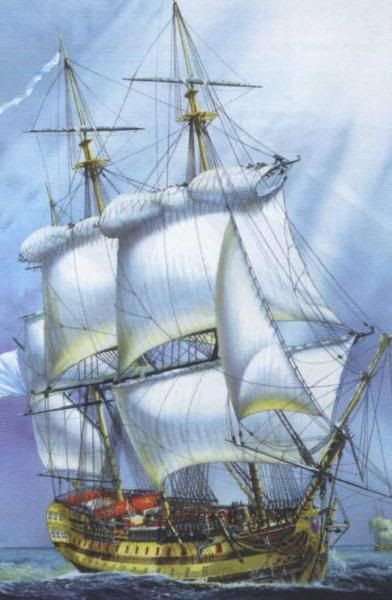The Victory is a tremendously valuable guide to scholars and modelers - one of the most valuable historical artifacts in existence. But she’s not a 100% reliable guide to the more subtle aspects of the appearance of real sailing ships.
She’s been replanked several times since the end of her active service, and the unfortunate realities of money and available materials have forced some big compromises with reality. Another concern of the preservationists is their desire to keep her basic structural fabric as intact as possible. Her lower masts, for instance, are steel tubes, and are not stepped on the keelson; iron rods welded to the masts go through the hull planking on either side of the keel and are imbedded in the concrete of the drydock. (That’s an extremely intelligent solution to the problems that would otherwise result from the huge forces of the rigging bearing on the keel assembly.) As I understand it, the wales on her sides are formed by relatively thin layers of wood fastened to the exterior of the hull planking. (The originals, of course, were huge pieces of timber - of the sort that would be prohibitively expensive today - fastened directly to the frames, with the “common plank” laid between them.) The pieces of the original wales were shaped in the “anchor stock” pattern; the current ones - unless they’ve been changed since the last time I saw her, which admittedly was quite a few years ago - are not. The reconstructed parts of the ship are full of compromises like that. Virtually all preserved and replica ships operate that way; the people who run them quickly discover that there just isn’t any choice.
In the eighteenth and nineteenth centuries the usual way to plank a ship’s hull (and deck, for that matter) was to bevel the edges of the planks, deliberately leaving a gap of an inch or so (maybe a bit less) between them on the exterior surface. After the planks had been laid, the caulker - a highly trained specialist, probably with several apprentices helping him - forced his caulking material (usually a mixture of old rope, oakum, and tar, kept heated in a pot) into the gap. The result was that the joints between the planks, especially in an unpainted hull, were in fact quite conspicuous. (Nineteenth-century photographs of ships on the launching ways often show the hull planking seams quite clearly, even when reproduced pretty small.) A coat of paint, of course, would make the seams much less conspicous. Whether the caulking would protrude slightly above the surface or be recessed slightly below it is an interesting question. I guess that may have varied, depending on how old the caulking job was, how the ship was working - and even the temperature, which might, I suppose, make the caulking swell a little.
How the planking seams ought to be represented on a model is, in my firm opinion, one of the many decisions that need to be left to the individual modeler. Model aircraft enthusiasts confront a similar problem. The grooves marking the edges of “metal panels” on even the finest Tamiya and Hasegawa 1/72-scale aircraft kits are, strictly speaking, grossly out of scale. If they were enlarged to full size the mechanics would be in danger of tripping over them.
My personal opinion is that, except on extremely small scales (smaller than 1/16"=1’), a hull with no visible planking seams doesn’t look right. (Many of the best, and most well-known, ship modelers seem to agree with me. Donald McNarry, who, if I were forced to bestow such titles, probably would get my vote for the title best ship modeler in the world, painstakingly mounts individual planks on models as small as 1/600 scale.) But to each his (or her) own. I’ve seen some mighty handsome and well-detailed models with no planking seams.
My bigger complaint with those two Heller ships of the line concerns the lack of deck camber. Their decks are perfectly flat - a mistake that’s pretty hard to excuse and harder to fix.




